Influence of Sintering Process on Microstructure and Mechanical Properties of Ti(C,N)-Based Cermet
Abstract
:1. Introduction
2. Experimental Details and Processes
2.1. Preparation of Materials
2.2. Test of Mechanical Properties
2.3. Microstructural Characterization
3. Results and Discussion
3.1. Sintering Influences on Microstructure and Composition
3.2. Sintering Influences on Mechanical Properties
4. Conclusions
- (1)
- When the sintering temperature fluctuated within the scope of 1400 °C–1450 °C, some grains began to grow unevenly and large grains with sharp points appeared. The material hardness decreases as sintering temperatures increase.
- (2)
- Mainly fracture toughness of materials is influenced by holding time. As holding time increases, the microstructure tends to be uniform, while core-rim structures become complete. If the holding time is too short, the sintering process will be insufficient, leading to poor compactness of materials and large grains. As a result, the fracture toughness of materials is reduced.
- (3)
- The sintering process did not influence the phase composition but affects the phase content and crystallinity. With the increase of sintering temperature, the Ni/Co peak is shifted to a higher angle.
Author Contributions
Funding
Conflicts of Interest
References
- Rajabi, A.; Ghazali, M.; Syarif, J.; Daud, A. Development and application of tool wear: A review of the characterization of TiC-based cermets with different binders. Chem. Eng. J. 2014, 255, 445–452. [Google Scholar] [CrossRef]
- Chen, C.; Guo, Z.; Li, S.; Xiao, Y.; Chai, B.; He, Y. Microstructure and properties of WC-17Co cermets prepared using different processing routes. Ceram. Int. 2019, 45, 9203–9210. [Google Scholar] [CrossRef]
- Okamoto, S.; Nakazono, Y.; Otsuka, K.; Shimoitani, Y.; Takada, J. Mechanical properties of WC/Co cemented carbide with larger WC grain size. Mater. Charact. 2005, 55, 281–287. [Google Scholar] [CrossRef]
- Zheng, Z.; Lin, N.; Zhao, L.; Li, X.; He, Y. Fabrication and wear mechanism of Ti(C,N)-based cermets tools with designed microstructures used for machining aluminum alloy. Vacuum 2018, 156, 30–38. [Google Scholar] [CrossRef]
- Xiong, J.; Guo, Z.; Shen, B.; Cao, D. The effect of WC, Mo2C, TaC content on the microstructure and properties of ultra-fine TiCN cermet. Mater. Design 2017, 28, 1689–1694. [Google Scholar] [CrossRef]
- Park, C.; Nam, S.; Kang, S. Enhanced toughness of titanium carbonitride-based cermets by addition of (Ti,W)C carbides. Mater. Sci. Eng. A 2016, 649, 400–406. [Google Scholar] [CrossRef]
- Qiu, W.; Liu, Y.; Ye, J.; Fan, H.; Qiu, Y. Effects of (Ti,Ta,Nb,W)(C,N) on the microstructure, mechanical properties and corrosion behaviors of WC-Co cemented carbides. Ceram. Int. 2017, 43, 2918–2926. [Google Scholar] [CrossRef]
- Yin, Z.; Yan, S.; Xu, W.; Yuan, J. Microwave sintering of Ti(C, N)-based cermet cutting tool material. Ceram. Int. 2018, 44, 1034–1040. [Google Scholar] [CrossRef]
- Xiong, J.; Guo, Z.; Yang, M.; Shen, B. Preparation of ultra-fine TiC0.7N0.3-based cermet. Int. J. Refract. Met. Hard Mater. 2008, 26, 212–219. [Google Scholar] [CrossRef]
- Deng, Y.; Jiang, X.; Zhang, Y.; Chen, H.; Tu, M.; Deng, L.; Zou, J. The effect of Co particle structures on the mechanical properties and microstructure of TiCN-based cermets. Mater. Sci. Eng. A 2016, 675, 164–170. [Google Scholar] [CrossRef]
- Wang, Y.; Kou, Z.; Liu, Y.; Liu, F.; Duan, W.; Deng, J.; Ma, Y.; Ma, D.; Tan, L.; Li, C.; et al. Ti (C, N)-based cermets sintered under high pressure. Int. J. Refract. Met. Hard Mater. 2016, 54, 203–209. [Google Scholar] [CrossRef]
- Peng, Y.; Miao, H.; Peng, Z. Development of TiCN-based cermets: Mechanical properties and wear mechanism. Int. J. Refract. Met. Hard Mater. 2013, 39, 78–89. [Google Scholar] [CrossRef]
- Xiong, H.; Wu, Y.; Li, Z.; Gan, X.; Zhou, K.; Chai, L. Comparison of Ti(C, N)-based cermets by vacuum and gas-pressure sintering: Microstructure and mechanical properties. Ceram. Int. 2018, 44, 805–813. [Google Scholar] [CrossRef]
- Zhang, Y.; Zheng, Y.; Zhong, J.; Yuan, Q.; Wu, P. Effect of carbon content and cooling mode on the microstructure and properties of Ti(C,N)-based cermets. Int. J. Refract. Met. Hard Mater. 2009, 27, 1009–1013. [Google Scholar] [CrossRef]
- You, Q.; Xiong, J.; Guo, Z.; Liu, J.; Yang, T.; Qin, C. Microstructure and properties of CVD coated Ti(C, N)-based cermets with varying WC additions. Int. J. Refract. Met. Hard Mater. 2019, 81, 299–306. [Google Scholar] [CrossRef]
- Dong, G.; Xiong, J.; Chen, J.; Guo, Z.; Wan, W.; Yi, C.; Chen, H. Effect of WC on the microstructure and mechanical properties of nano Ti(C,N)-based cermets. Int. J. Refract. Met. Hard Mater. 2012, 35, 159–162. [Google Scholar] [CrossRef]
- Liu, C.; Lin, N.; He, Y. Influence of Mo2C and TaC additions on the microstructure and mechanical properties of Ti(C, N)-based cermets. Ceram. Int. 2016, 42, 3569–3574. [Google Scholar] [CrossRef]
- Wu, P.; Zheng, Y.; Zhao, Y.; Yu, H. Effect of TaC addition on the microstructures and mechanical properties of Ti(C,N)-based cermets. Mater. Des. 2010, 31, 3537–3541. [Google Scholar] [CrossRef]
- Wang, J.; Liu, Y.; Feng, Y.; Ye, J.; Tu, M. Effect of NbC on the microstructure and sinterability of Ti(C0.7, N0.3)-based cermets. Int. J. Refract. Met. Hard Mater. 2009, 27, 549–551. [Google Scholar] [CrossRef]
- Lin, N.; Zhao, L.; Zou, J.; Ma, C.; Wang, Z.; He, Y. Improvement in densification process and properties of Ti(C,N)-based cermets with vanadium carbide addition. Ceram. Int. 2019, 45, 2692–2700. [Google Scholar] [CrossRef]
- Wang, J.; Liu, Y.; Zhang, P.; Ye, J.; Tu, M. Effect of VC and nano-TiC addition on the microstructure and properties of micrometer grade Ti(CN)-based cermets. Mater. Des. 2009, 30, 2222–2226. [Google Scholar] [CrossRef]
- Kang, X.; Lin, N.; He, Y.; Zhang, M. Influence of ZrC addition on the microstructure, mechanical properties and oxidation resistance of Ti(C,N)-based cermets. Ceram. Int. 2018, 44, 11151–11159. [Google Scholar] [CrossRef]
- Xu, Q.; Ai, X.; Zhao, J.; Zhang, H.; Qin, W.; Gong, F. Effect of heating rate on the mechanical properties and microstructure of Ti(C,N)-based cermets. Mater. Sci. Eng. A 2015, 628, 281–287. [Google Scholar] [CrossRef]
- Dong, D.; Yang, W.; Xiong, H.; Zhang, L.; Shi, K.; Liao, J. Ti(C,N)-based cermets with fine grains and uniformly dispersed binders: Effect of the Ni–Co based binders. Ceram. Int. 2020, 46, 6300–6310. [Google Scholar] [CrossRef]
- Shetty, D.K.; Wright, I.G.; Mincer, P.N.; Clauer, A.H. Indentation fracture of WC-Co cermets. J. Mater. Sci. 1985, 20, 1873–1882. [Google Scholar] [CrossRef]
- Zhou, S.Z.; Wang, S.Q.; Peng, W.Z.; Wang, L.S. Effect of sintering atmosphere on structure and properties of Ti(CN) base cermets. Trans. Nonferrous Met. Soc. China 2005, 15, 1350–1357. [Google Scholar] [CrossRef]
- Xu, Q.; Ai, X.; Zhao, J.; Gong, F.; Pang, J.; Wang, Y. Effects of metal binder on the microstructure and mechanical properties of Ti(C,N)-based cermets. J. Alloy. Compd. 2015, 644, 663–672. [Google Scholar] [CrossRef]
- Gan, X.; Xie, D.; Yang, Q.; Zhou, K.; Xiong, H. Ti(C, N)-based cermets by vacuum sintering using commercial composite powders: Morphology evolution, composition and related properties. Vacuum 2019, 170, 108983. [Google Scholar] [CrossRef]
- Zhou, H.; Huang, C.; Zou, B.; Liu, H.; Zhu, H.; Yao, P.; Wang, J. Effects of sintering processes on the mechanical properties and microstructure of Ti(C,N)-based cermet cutting tool materials. Int. J. Refract. Met. Hard Mater. 2014, 47, 71–79. [Google Scholar] [CrossRef]
- Zackrisson, J.; Andrén, H.-O. Effect of carbon content on the microstructure and mechanical properties of (Ti, W, Ta, Mo)(C, N)–(Co, Ni) cermets. Int. J. Refract. Met. Hard Mater. 1999, 17, 265–273. [Google Scholar] [CrossRef]
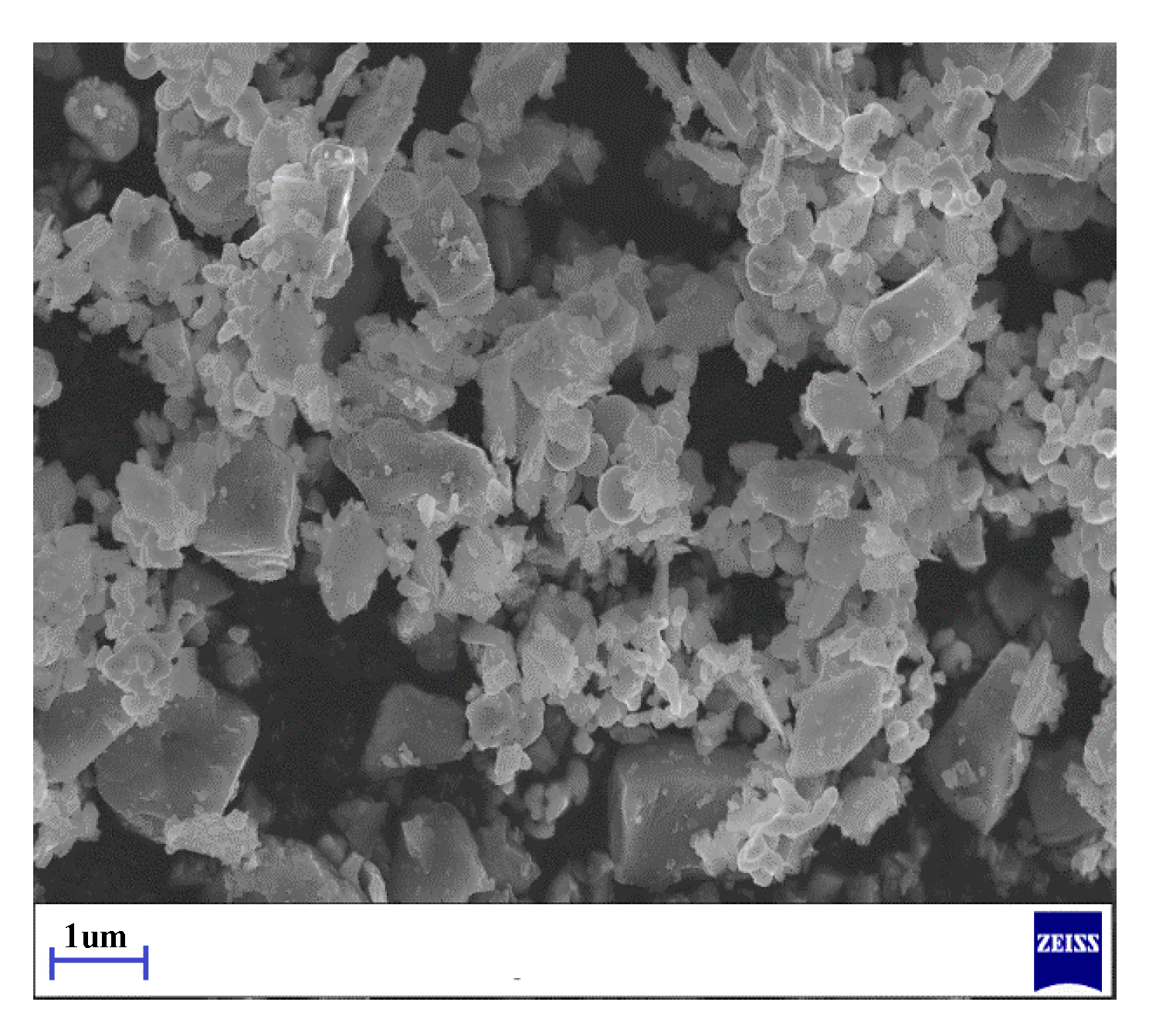
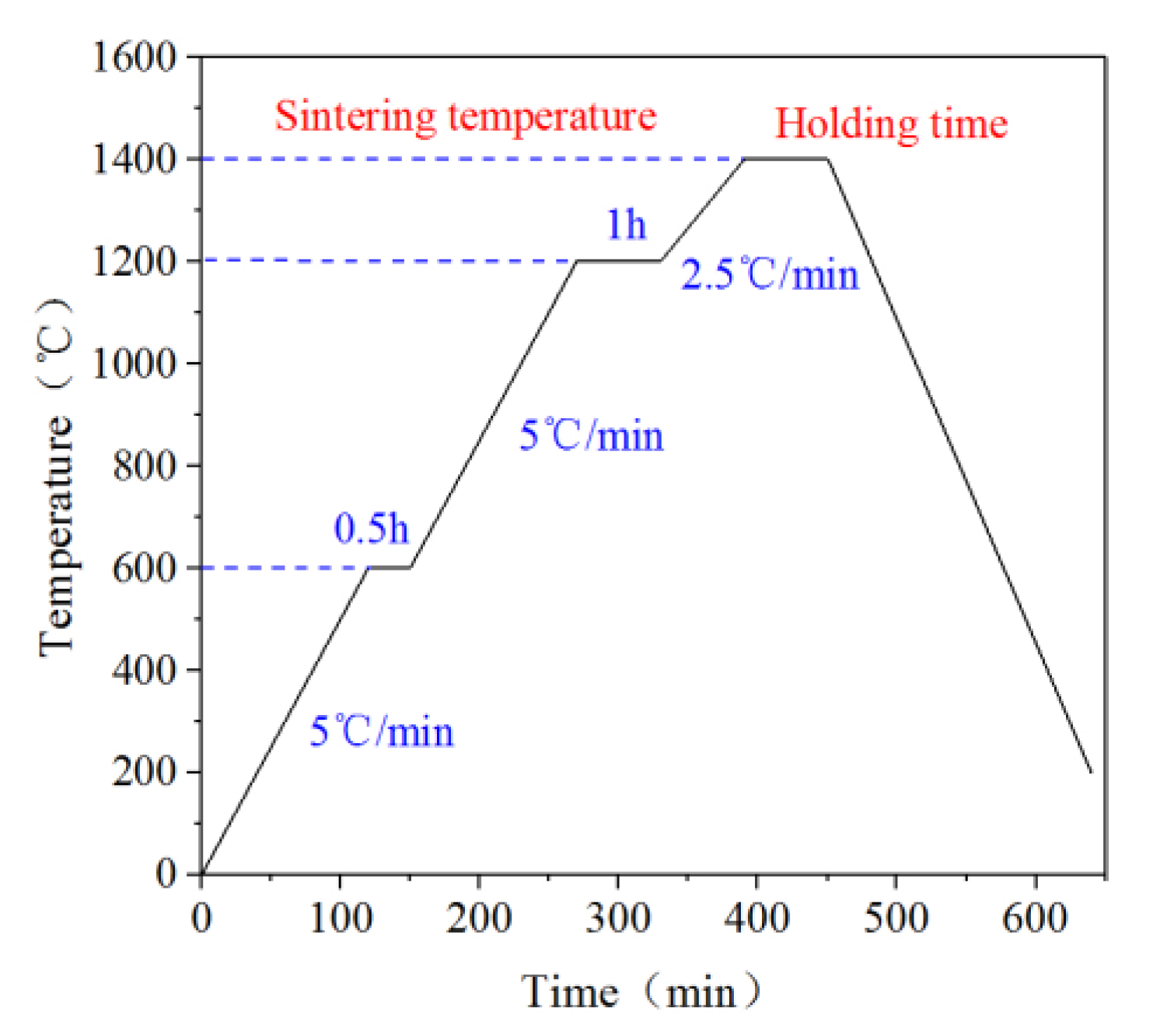


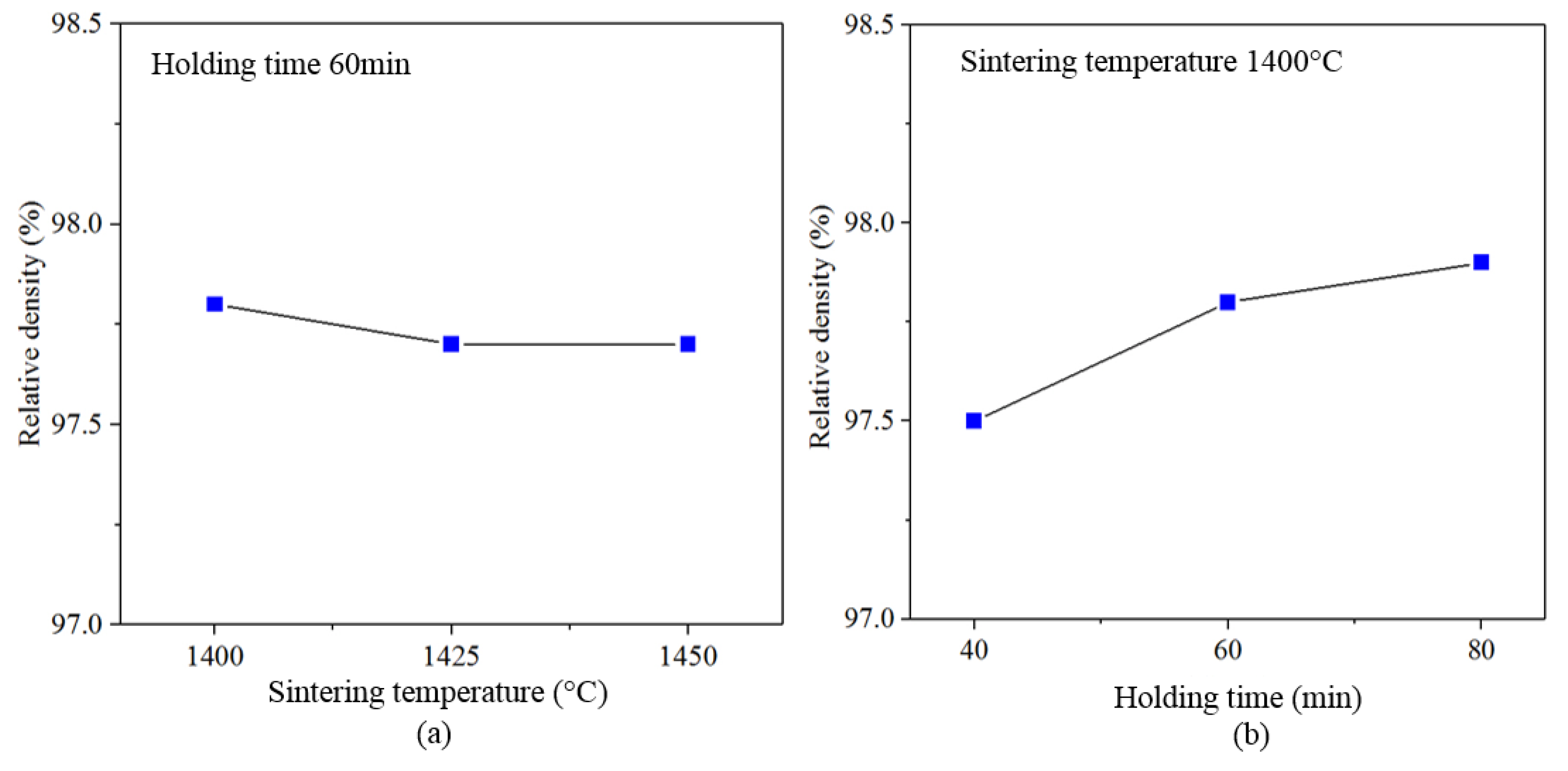
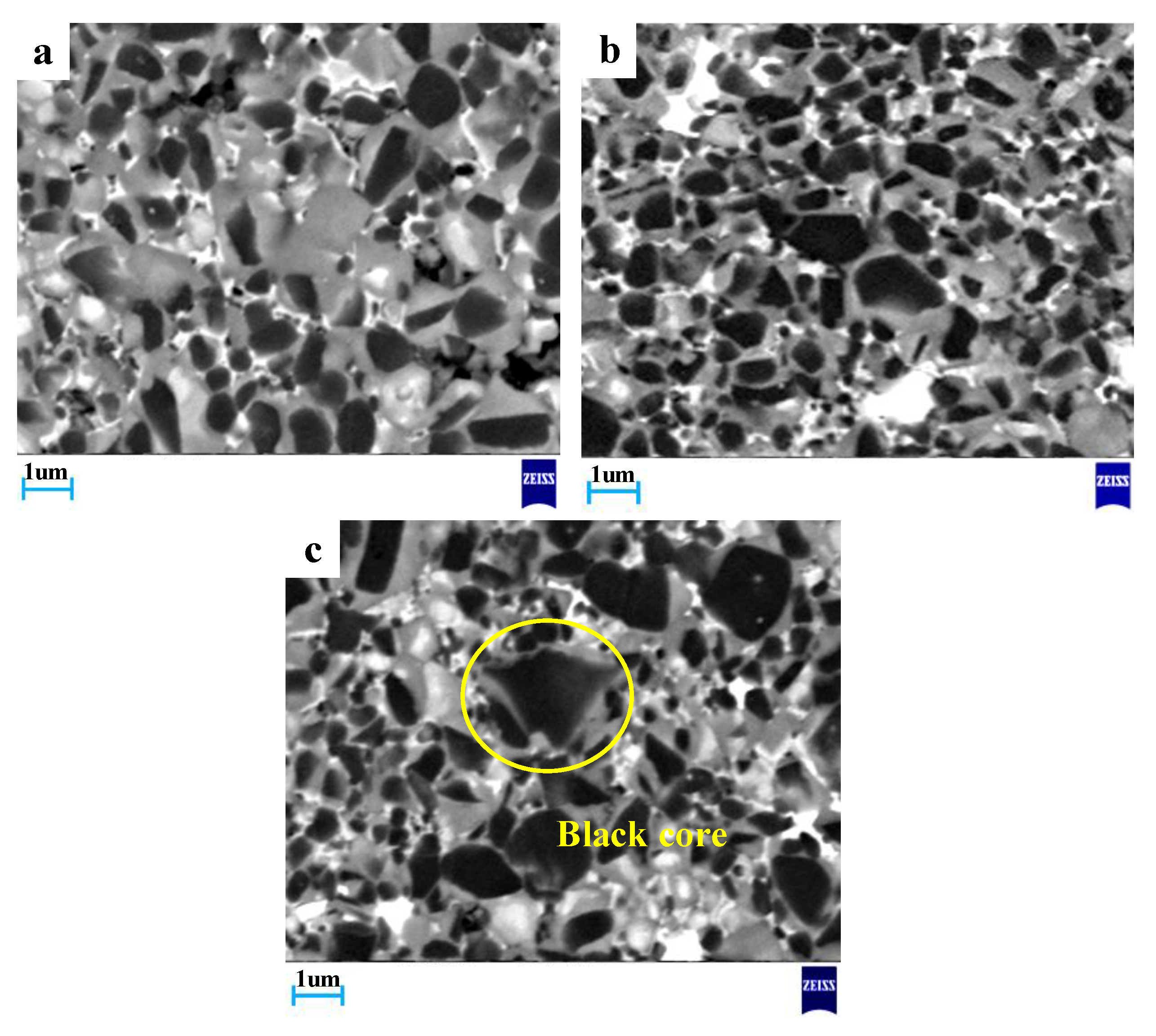
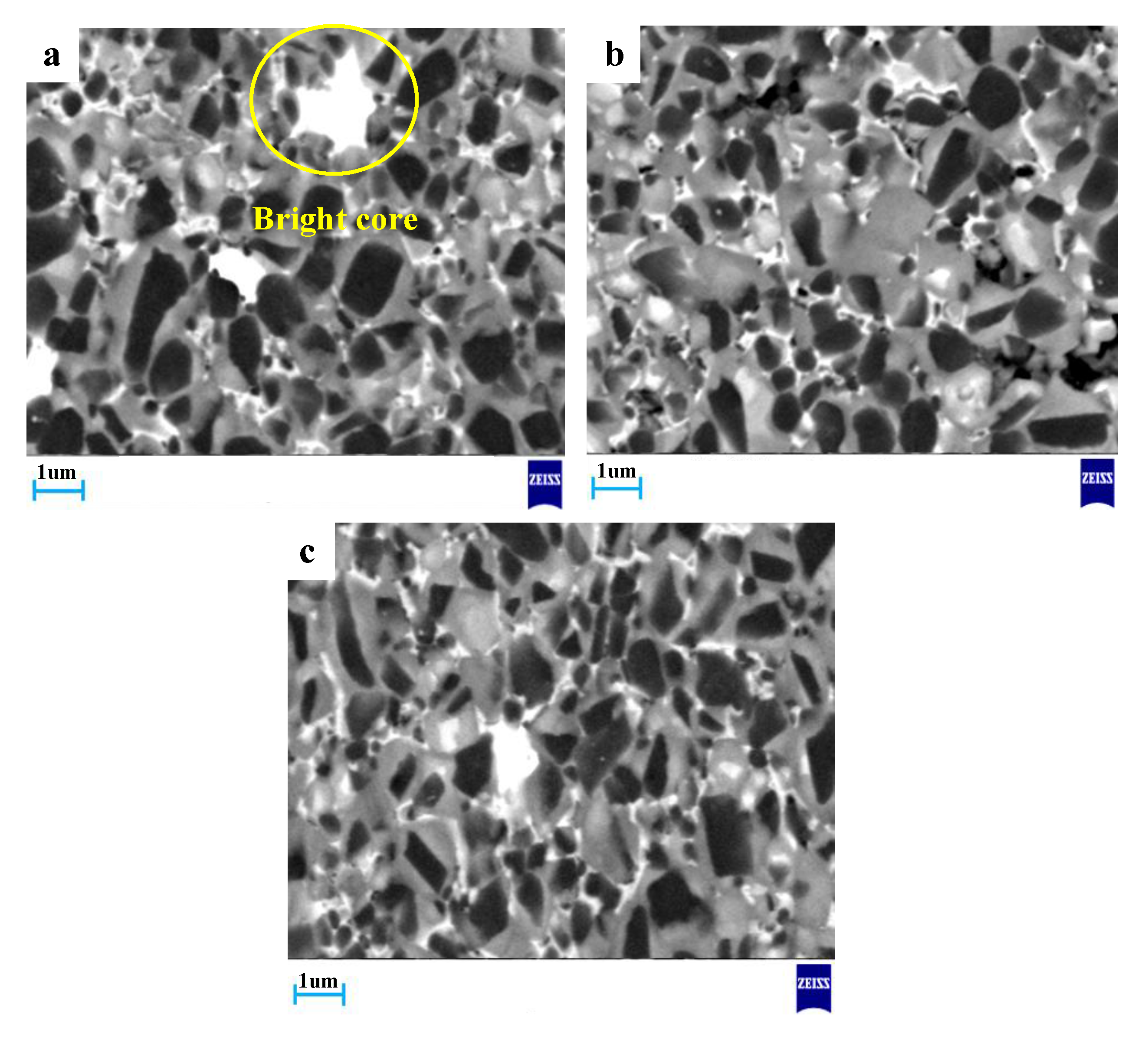

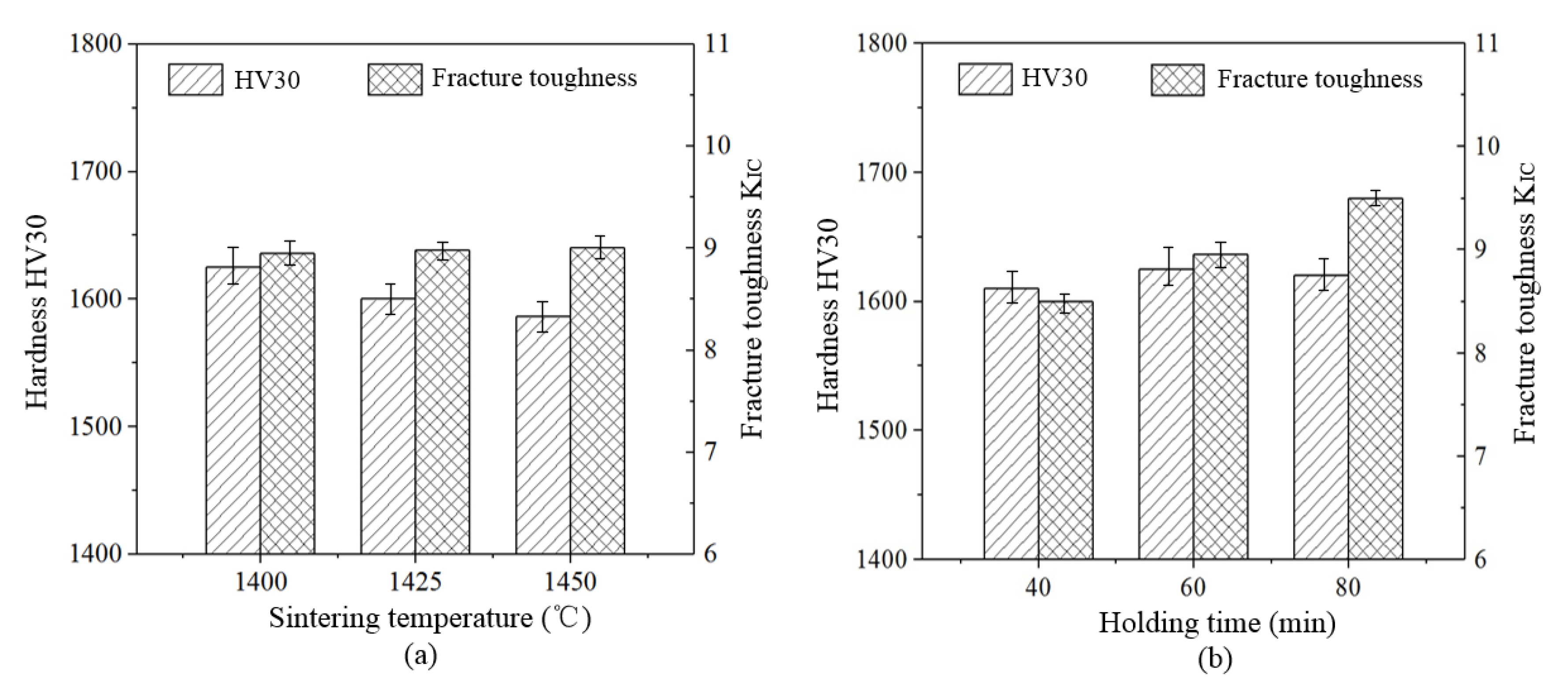
| Powders | Grain Size (d50/µm) | Purity (wt.%) | Impurity (wt.%) | Manufacturer | ||
|---|---|---|---|---|---|---|
| Ti(C0.5,N0.5) | 0.5 | 99.6 | O (<0.08) | Na (0.004) | Al (0.002) | Beijing Xiongrongyuan Technology Co., Ltd. (Beijing, China) |
| WC | 0.4 | 99.6 | O (<0.08) | N (0.002) | Al (0.002) | Xiamen Golden Egret Special Alloy Co., Ltd. (Xiamen, China) |
| TaC | 0.5 | 99.8 | O (<0.20) | N (0.002) | K (0.002) | Shanghai Chaowei Nanotechnology Co., Ltd. (Shanghai, China) |
| MoC | 0.4 | 99.9 | C (0.01) | Fe (0.005) | Si (0.003) | |
| Ni | 0.8 | 99.9 | S (0.004) | Fe (0.004) | O (<0.004) | |
| Co | 2.2 | 99.0 | O (0.23) | Fe (0.019) | C (0.09) | |
| Element (at.%) | Ti | C | W | Mo | Ta | N | Co | Ni |
|---|---|---|---|---|---|---|---|---|
| Black core | 50.08 | 9.87 | 15.24 | 2.36 | 2.24 | 5.62 | 6.89 | 7.69 |
| Grayish rim | 59.05 | 11.15 | 29.80 | 0.2 | 0. | 0 | 0 | 0 |
| Bright core | 62.6 | 10.98 | 15.47 | 1.51 | 0.2 | 9.43 | 0 | 0 |
© 2020 by the authors. Licensee MDPI, Basel, Switzerland. This article is an open access article distributed under the terms and conditions of the Creative Commons Attribution (CC BY) license (http://creativecommons.org/licenses/by/4.0/).
Share and Cite
Ji, K.; Meng, Y.; Wang, F.; Li, Y. Influence of Sintering Process on Microstructure and Mechanical Properties of Ti(C,N)-Based Cermet. Materials 2020, 13, 3938. https://doi.org/10.3390/ma13183938
Ji K, Meng Y, Wang F, Li Y. Influence of Sintering Process on Microstructure and Mechanical Properties of Ti(C,N)-Based Cermet. Materials. 2020; 13(18):3938. https://doi.org/10.3390/ma13183938
Chicago/Turabian StyleJi, Kaixun, Yanxin Meng, Fuzeng Wang, and Yousheng Li. 2020. "Influence of Sintering Process on Microstructure and Mechanical Properties of Ti(C,N)-Based Cermet" Materials 13, no. 18: 3938. https://doi.org/10.3390/ma13183938




